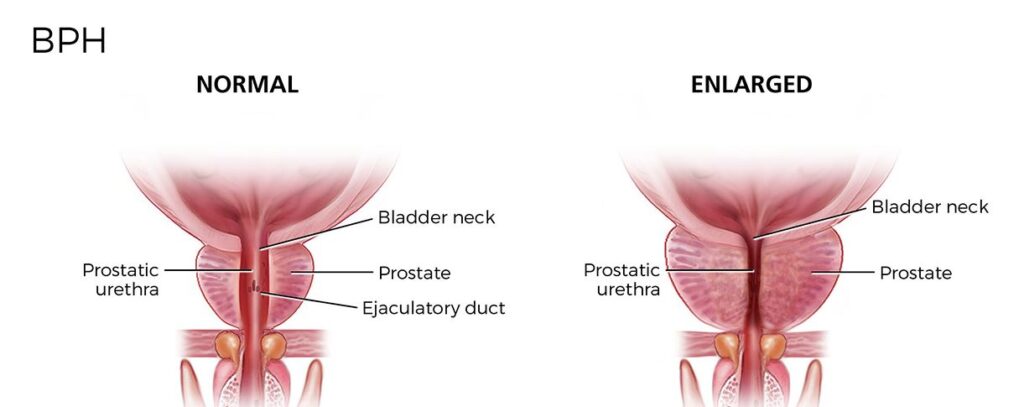Understanding Your Options for Relief
Benign Prostatic Hyperplasia (BPH) is a common condition in aging men where the prostate enlarges and begins to block the flow of urine—like a clamp on a garden hose. While medications can improve symptoms, it’s important to understand that they treat the symptoms, not the obstruction itself.
Think of BPH as a blocked pipe. Medications may help with the flow, but they don’t get to the root of the blockage in the pipe.
What’s Happening in Your Body?
A healthy prostate (left) allows urine to flow freely. In BPH (right), the enlarged prostate compresses the urethra.
BPH Medication Options
1. Alpha-Blockers
(Examples: Tamsulosin, Alfuzosin, Silodosin)
-
Action: Relax muscles around the bladder neck and prostate
-
Onset: Quick—often within days
-
Efficacy: Improves symptoms in 60–70% of men
-
Limitations: Does not shrink prostate or prevent progression
Side Effects:
-
Dizziness, blood pressure decrease
-
Retrograde ejaculation
-
Nasal congestion
-
Risk of floppy iris syndrome in eye surgery
2. 5-Alpha Reductase Inhibitors (5-ARIs)
(Examples: Finasteride, Dutasteride)
-
Action: Shrink the prostate over time by lowering DHT
-
Onset: Slower—6 to 12 months
-
Efficacy:
-
Shrinks prostate by ~20–25%
-
Reduces risk of surgery or retention by ~50% (MTOPS trial)
-
Side Effects:
-
Decreased libido
-
Erectile dysfunction
-
Rare: breast tenderness or depression
3. Combination Therapy (Alpha-Blocker + 5-ARI)
(Example: Jalyn)
-
Benefit: Immediate symptom relief + long-term reduction in prostate size
-
Best for: Men with moderate-to-severe symptoms and large prostates
Data from MTOPS Trial:
-
Combination therapy delayed progression more than either drug alone
-
Risk of progression reduced by 66% with combination therapy
-
Also led to greater improvement in symptom scores and lower need for surgery
4. Cialis (Tadalafil) for BPH
-
Brand name: Cialis
-
Dose: Typically 5 mg daily
-
FDA-approved for both erectile dysfunction and BPH
-
How it works: Relaxes muscle in the prostate and bladder, improving urine flow
Efficacy:
-
Improves International Prostate Symptom Score (IPSS) by ~4–5 points vs placebo
- Subjectively improves feeling of obstruction, minimal quantitative improvement objectively
-
Onset may be slower than alpha-blockers but benefits both urinary symptoms and sexual function
Side Effects:
-
Headache
-
Back pain
-
Indigestion
-
Rare: visual changes, priapism (prolonged erection)
Note: Cialis is often ideal for men with both BPH and ED.
Key Takeaways
-
Medications can significantly reduce symptoms and delay progression, but they don’t cure BPH.
-
They’re best thought of as a long-term management tool—not a permanent fix.
-
If symptoms persist or worsen despite medications, minimally invasive procedures or surgery may offer better long-term results.
When Medications Stop Working: What’s Next?
It’s not uncommon for men with BPH to feel that their medications aren’t working as well as they used to. This could mean that the prostate has grown, the bladder is under more strain, or that the root cause of your symptoms isn’t being fully addressed by medications alone.
If you’ve noticed a return of symptoms like frequent urination, weak stream, or incomplete emptying, don’t worry—there are still excellent options available.
Step 1: Medication Adjustment
Sometimes, a dosage increase or change in medication class (e.g., switching alpha-blockers or adding a 5-alpha-reductase inhibitor) may help. This is often the first step if medications had been effective in the past but are now wearing off.
Step 2: Diagnostic Evaluation
If increasing or changing medications isn’t enough, it’s time for a closer look. We may recommend:
-
Cystoscopy: A quick in-office procedure using a small camera to look inside your urethra and bladder to identify narrowing or obstruction.
-
Transrectal Ultrasound (TRUS): Measures the size and anatomy of the prostate to guide further treatment decisions.
-
Urodynamic Studies: A functional test that measures how well your bladder fills and empties, especially useful when symptoms don’t match up with prostate size.
These tests help us understand whether the problem lies with the prostate, bladder, or both—and what treatment is likely to help most.
Step 3: Considering Procedural or Surgical Options
If medications are no longer effective or tolerable, it may be time to consider a minimally invasive procedure or surgical solution. These treatments are often done in-office or as outpatient surgery, with excellent long-term success rates and minimal downtime.
At Fore River Urology, we offer a range of safe, effective options, including:
- Prostate Artery Embolization
- Aquablation
- TURP
-
GreenLight™ laser therapy
We tailor the approach to your prostate size, health goals, and lifestyle.
You’re not out of options—just ready for the next step. Our goal is to help you regain quality of life with the least disruption and the best results.
Ready to Re-Evaluate Your BPH Treatment?
Speak with our board-certified urologists at Fore River Urology about your symptoms and treatment options. Whether it’s medications or a procedure, we’ll help you choose what’s best for your lifestyle and goals.
Call 207-518-6600 or Request an Appointment

